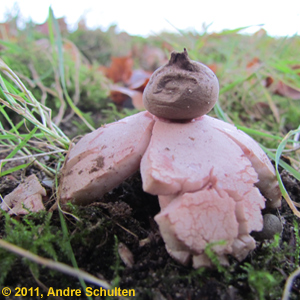
Photo : Rosy Earthstar
André Schulten, Arnhem,
November 30 2011 |
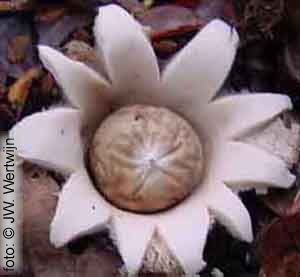
Photo: Rosy Earthstar
Ahaus, Wuellen (Germany),
October 10 2000 |
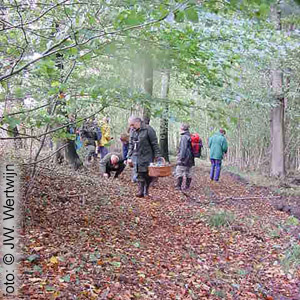
Photo: NMV study-week
Rosy Earthstar
Wuellen (Germany) |
Rosy Earthstar
(Geastrum rufescens)
Syn.: Geastrum schaefferi Vittadini, Geastrum vulgatum vittadini.
NMV Ga 211150
My first Rosy Earthstar I found in Germany, during a study-week of the Dutch Mycology Union (NMV) near Winterswijk.
There was a guided tour near Ahaus in the neighboorhood Wuellen in a piece of forest on a calcareous slope of a hill with a remarkable vegetation.
There were many curiosities in the wood, and a group of active mycologists was gathered to report it all.
There, in the Wuellen forest, in a beech lane, along the side of the path, full of half-wasted leaves and clayi humous,
I found my very first Rosy Earthstar. On top of a little bit elevated, relative dry, poor place between the Beech-nuts.
|
|
If species are so rare, that you never see them again, mistakablity is possible.
And there are a lot of earthstars with a brownish-rosy tint:
Rosy Earthstar is the only one which is coloring red upon injuring. Scratch it with your nails, and see the resulting red.
Other earthstar sometimes are coloring rosy during growth on their own.
Especially those species with thick fresh star-rays can coloring brown-rosy
at the moment the bulb is opening, and at the moment the meat of the star-rays is cracking off.
Bulbs from Rosy Earthstar are flattened globose (spherical), growing underground, and having encrusted debris.
|
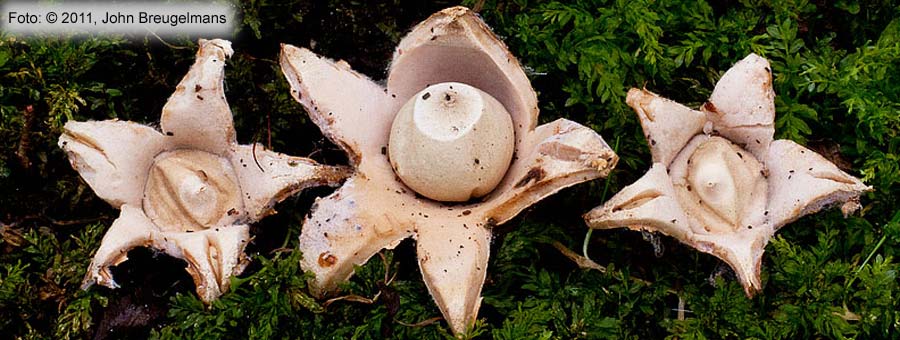
Foto: Collared Earthstar in Rosy Outfit |
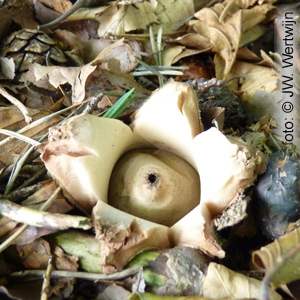
Photo: Collared Earthstar,
Kivietsdal, KNNV-Gooi-excursie,
September 5 2010
Self-injuring causes brownish-rosy tint |
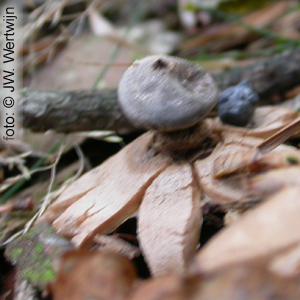
Photo: Beaked Earthstar,
Zuiderhei ('t Bluk).
October 9. 2005
Self-injuring causes brownish-rosy tint |
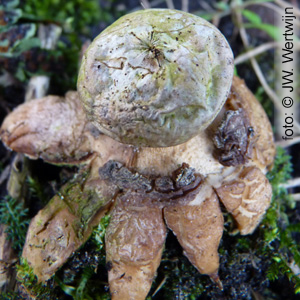
Photo: Crowned Earthstar,
Meijendel,
November 30 2011
Self-injuring causes brownish-rosy tint |
How to exclude mistakability:
- Turn the earthstar upside down
- Encrusted debris ?
- Scar ?
- Do the injuring test. Coloring red ?
- Real earthstar specialists look at the mouth-zone: fibrillose, no court, no ring-furrow, no conic shape !
|

Photo's: André Schulten
Rosy Earthstar, November 30 2011,
Arnhem |
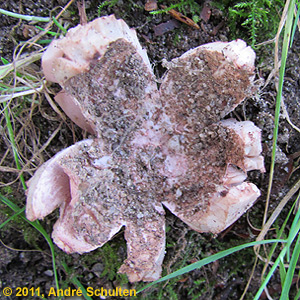
Habitat:
Beech, on poor soil,
at village border |
|
|
Field-marks: See: Anatomy Genus Geastrum
Rosy Earthstar field-marks:
- Species size: medium
- Stem (below balloon): short (1-3 mm) and broad (3-6-9 mm), sometimes oval or rare without stem; without apophyse
- Stem color: if there is a stem, then the stem and the balloon have the same color
- Balloon surface: fine felty to bald
- Balloon color: young light grey-brown
- Balloon color: older brown, like Collared Earthstar brown, sometimes with a rosy tint
- Balloon mouth-zone: fibrillose, flat to conical, no border, no court, no ring-furrow
- Star-rays number: 5-9
- Star-rays-thickness: young upto 7 mm (a young Collared Earthstar is upto 5 mm)
- Star-rays-color: meaty layer young creme-rosy
- Star-rays-color: meaty layer old/injured wine-red or brown-red
- Star-rays: non-hygroscopic
- Star-rays-encrusted debris: yes
- Star-rays-scar: no
|
Habitat:
Rosy Earthstar is an forest-earthstar of deciduous wood. Often at dry to moisty sandy soil.
Found on calcareous and calcareous-poor soil. In the Netherlands it is an earthstar found at more fertile, litterish places.
In Scandinavia this earthstar seems to prefer calcareous soil, and has been found in coniferous forests as well.
Wood species: Deciduous wood (Beech, Elm, Lime, Oak)
Regional:
Urban Amsterdam Area: No.
Pleistocene Area: Before 1950 found in the trail of the current highway A27.
Northsea Dunal Area: Recently found in the inner dunal area.
|
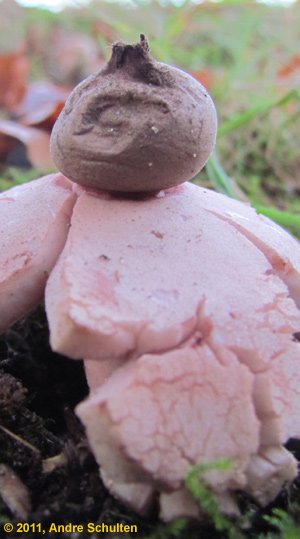 |
Mistakability:
- Dried or old Collared Earthstar
same size, with a scar, no encrusted debris
- Fresh and young Sessile Earthstar
smaller size, encrusted debris, no scar, other color, no color change upon injuring
- Crowned Earthstar
same size, encrusted debris, no scar, no color change upon injuring, mouth-zone is clearly distinct, a stem
and a rounded bag-shaped apophyse.
|
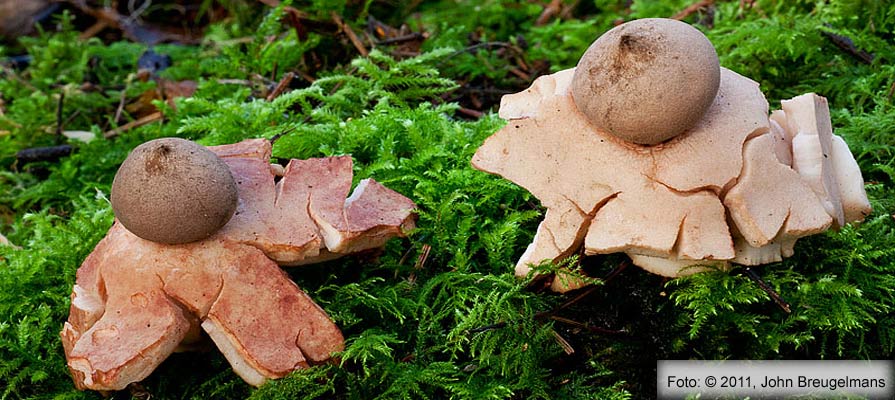
Photo: Rosy Earthstar (Geastrum rufescens)
|
Literature:
Chrispijn, R. ed. (1999), Champignons in de Jordaan (De paddenstoelen van Amsterdam), Schuyt en Co, 162-163.
Gerhardt (2006), De grote Paddenstoelen Gids (voor onderweg), Tirion Natuur, 616.
Hansen, L & K. Knudsen (1997), Nordic Macromycetes, Kopenhagen, Vol 3, 345.
Jalink (1995), De aardsterren van Nederland en België, Coolia 38 supplement, 59-60.
Pegler, e.o. (1995), British puffballs, earthstars and stinkhorns, an account of the british gasteroid fungi, Royal Botanic Gardens, kew, 1995, 255 pp.
Vermeulen (1999), Paddestoelen, Schimmels en Slijmzwammen van Vlaanderen, Wielewaal, Turnhout, 541.
www.mycobank.com
|
Top
|